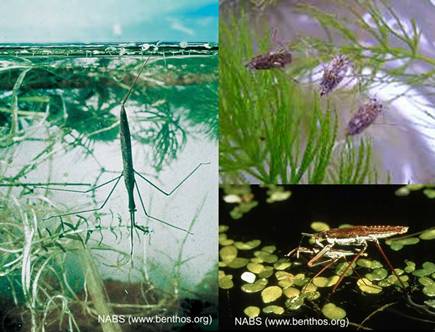Home → Water Quality → Monitoring & Reporting → Biomonitoring → Sampling & Analysis → Macroinvertebrate Types → Flat Worms True Bugs
 True Bugs (Hemiptera)
True Bugs (Hemiptera)
True bugs are a diverse order, comprised mostly of species that are terrestrial as both larvae and adults. Aquatic true bugs comprise only 400 of the 3600 species of true bugs in North America , but they come in all shapes and sizes, ranging from 3-65 mm in adult length. Their larvae can be distinguished from other aquatic insects by their beak or cone-like mouthparts, wing pads, claws at the ends of at least one pair of their three pairs of segmented legs, and lack of gills. Adults are identified mostly by their wings. The base of the front wing is leathery and not transparent, while the remainder of the front wings and the hind wings are transparent. When not in use, the wings fold so that they lie flat, with a slight overlap.
Aquatic true bugs also spend a much longer period of time as adults than other aquatic insects. Most spend only 1-2 months as larvae, and can spend up to six months as adults before mating. All true bugs live in the same habitat as larvae and adults. Although true bugs undergo incomplete metamorphosis as they transition into adulthood, this series of molts doesn't produce as dramatic a transformation as it does for other insects that transition into a terrestrial adult. The lack of fully developed wings is the only feature distinguishing larvae from adults.
Both larval and adult true bugs, with the exception of water boatmen, are piercer predators that feed on other invertebrates. They use their distinctive cone-like mouthparts to stab prey, pump in enzymes that dissolve its tissues, and suck out the resulting juices. Water boatmen eat whatever living material they can find in the bottom sediment-usually algae and small invertebrates.
Almost all aquatic true bugs are found only in still water, such as ponds, lakes, or calm areas in running waters. They can be found in a wide variety of habitat sizes, ranging from springs to rivers and intermittent ponds to lakes. Some types of true bug thrive in unusual conditions, such as areas with high salinity, temperature, or pollution.
Unlike many aquatic insects, true bugs don't have gills. They rely on oxygen from the air that they absorb through their bodies. For true bugs that spend their time on the waters surface in contact with the air, this process is fairly straightforward. Other true bugs that spend their time submerged carry air bubbles with them under their wings or trapped in body hairs. Because they don't rely on dissolved oxygen in the water, some types of true bug can thrive in very polluted conditions.
Picture key
Left: Water scorpion (Ranatra sp.)
Top Right: Water boatmen (Notonectidae)
Bottom Right: Water strider (Gerridae)
Source: All photos from Tne North American Benthological Society
Bibliography
Voshell, Jr., J. Reese; illustrated by Amy Bartlett Wright. 2002. A Guide to Common Freshwater Invertebrates of North America. Blacksburg (VA): The McDonald & Woodward Publishing Company. 442 p